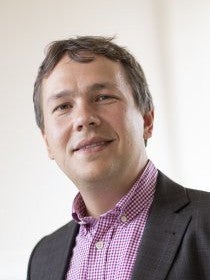The unique ability of carbon to bond with itself forming extended chains and networks underlies the structural complexity of organic matter. This complexity extends to elemental carbon. Several hundred crystalline carbon phases have been theoretically predicted to date. However, few of these materials have been realized experimentally. Advances in the synthesis of nonbenzenoid and sp1-containing allotropes have been especially limited. One of such allotropes is γ-graphyne, an sp2/sp1 carbon lattice which can be viewed as graphene uniformly expanded through insertion of two-carbon acetylenic units.1 γ-Graphyne is predicted to be a semiconductor with a moderate band gap, ultrafast charge carrier mobility comparable to that of graphene, and high thermal conductivity.2 Recently our group reported the synthesis of multilayer γ-graphyne through crystallization-assisted irreversible polymerization.3 While conventional 2D polymerizations and reticular chemistry rely on error correction through reversibility, we demonstrated that a covalent lattice of high quality can be synthesized under purely kinetic control. Initial experiments indicate that γ-graphyne is a semiconductor with a bandgap of ~0.5 eV. The crystal structure features aperiodic sheet stacking with an interlayer distance of 3.48 Å. The material is thermally stable up to 240 °C but undergoes a rapid photochemical transformation under green or longer-wavelength light. In this presentation, I shall discuss our recent progress in exploring the physical and chemical properties of this novel form of carbon.

Valentin Rodionov began his undergraduate studies in 1997 at the Higher Chemical College of the Russian Academy of Sciences. In 2000, after moving to the United States, he was accepted to the University of Maryland and promoted directly into the graduate program without having to complete an undergraduate degree. He earned his M.S. in 2002 and enrolled in the Ph.D. program at the Scripps Research Institute in La Jolla, CA. At Scripps Dr. Rodionov worked under the guidance of Profs. M.G. Finn and K.B. Sharpless. His thesis project was focused on mechanistic investigation of copper (I) catalyzed azide-alkyne cycloaddition and provided the first glimpse of the inner workings of this most widely used "click" reaction. As a postdoctoral fellow with Professor J.M.J. Fréchet at the University of California, Berkeley, Dr. Rodionov applied the powerful “click” chemistry approach to the development of enzyme-inspired catalytic. Since late 2010, Dr. Rodionov has been an Assistant Professor of Chemical Science at King Abdullah University of Science and Technology (KAUST), Saudi Arabia. The group has transitioned to Case Western Reserve University in 2018. Prof. Rodionov’s research interests are broadly focused on catalysis with soft materials and chemistry of nonbenzenoid allotropes of carbon.
